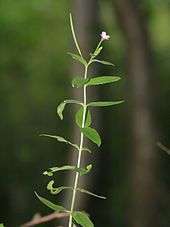Epilobium parviflorum
| Epilobium parviflorum | |
|---|---|
| | |
| Flowers | |
| Scientific classification | |
| Kingdom: | Plantae |
| (unranked): | Angiosperms |
| (unranked): | Eudicots |
| (unranked): | Rosids |
| Order: | Myrtales |
| Family: | Onagraceae |
| Genus: | Epilobium |
| Species: | E. parviflorum |
| Binomial name | |
| Epilobium parviflorum (Schreb.) Schreb. | |
| Synonyms | |
|
Chamaenerion parviflorum | |
Epilobium parviflorum, commonly known as the hoary willowherb[1] or smallflower hairy willowherb,[2] is a herbaceous perennial plant belonging to the Onagraceae family.
Etymology
The genus name derives from the Greek words "epi" meaning "upon" and "lobos" meaning "lobe", with reference to position of the petals above the ovary. The specific Latin name of "parviflorum" means "small flowers".
Description

The biological form of Epilobium parviflorum is hemicryptophyte scapose,[3] as its overwintering buds are situated just below the soil surface and the floral axis is more or less erect with a few leaves.
Epilobium parviflorum reaches on average 30–80 centimetres (12–31 in) in height.[3] The stem is erect and densely covered with hairs, especially in the lower part. The leaves are opposite, unstalked but not amplexicaul, lanceolate and toothed, rounded at the base, 4–10 centimetres (1.6–3.9 in) long. The tiny flowers are pale pink or pale purple, 6–7 millimetres (0.24–0.28 in) in diameter, with four petals, eight stamens and a 4-lobed stigma. Flowering occurs from June to August.[3] The hermaphroditic flowers are either self-fertilized (autogamy) or pollinated by insects (entomogamy).[4] Fruit is a three-to seven-centimeter long capsule containing very small black seeeds (about 1 mm long), with white fibres that allow the dispersal by wind. This species is quite similar to Epilobium hirsutum, but the flowers are much smaller.[5]
Distribution
This plant occurs in most of Europe, including Britain, from Sweden to Northern Africa and Western Asia up to India, in USA and Canada.[6] [7]
Habitat
It prefers marshes and swamps, moist mountain meadows and slopes, at an average altitude of 0–1,400 metres (0–4,593 ft) above sea level,[3] with a maximum of 2,500 metres (8,200 ft).
Medicinal uses
Extracts of this plant have been used by traditional medicine in disorders of the prostate gland, bladder and kidney, having an antioxidant and antiinflammatory effect .[8][9][10] Epilobium parviflorum herb has been prescribed internally as tea in the traditional Austrian medicine for treatment of disorders of the prostate, kidneys, and urinary tract.[11] Extracts of Epilobium have been shown to inhibit proliferation of human prostate cells in-vitro by affecting progression of the cell cycle.[12]
References
- ↑ "BSBI List 2007". Botanical Society of Britain and Ireland. Archived from the original (xls) on 2015-02-25. Retrieved 2014-10-17.
- ↑ "Epilobium parviflorum". Natural Resources Conservation Service PLANTS Database. USDA. Retrieved 18 January 2016.
- 1 2 3 4 Pignatti S. - Flora d'Italia – Edagricole – 1982. Vol. II, pag. 155
- ↑ Pfaf.org
- ↑ Flora of Northern Ireland
- ↑ Plants.usda
- ↑ Schede di Botanica
- ↑ Natures Method
- ↑ Hevesi, BT; Houghton, PJ; Habtemariam, S; Kéry, A (May 2009). "Antioxidant and antiinflammatory effect of Epilobium parviflorum Schreb". Phytotherapy Research 23 (5): 719–724. doi:10.1002/ptr.2725. PMID 19107731.
- ↑ V. Steenkamp, M. C. Gouws, M. Gulumian, E. E. Elgorashi, J. van Staden (January 2006). "Studies on antibacterial, anti-inflammatory and antioxidant activity of herbal remedies used in the treatment of benign prostatic hyperplasia and prostatitis". Journal of Ethnopharmacology 103 (1): 71–75. doi:10.1016/j.jep.2005.07.007. PMID 16122891.
- ↑ Vogl, S; Picker, P; Mihaly-Bison, J; Fakhrudin, N; Atanasov, AG; Heiss, EH; Wawrosch, C; Reznicek, G; Dirsch, VM; Saukel, J; Kopp, B (2013). "Ethnopharmacological in vitro studies on Austria's folk medicine - An unexplored lore in vitro anti-inflammatory activities of 71 Austrian traditional herbal drugs". J Ethnopharmacol 149 (3): 750–71. doi:10.1016/j.jep.2013.06.007. PMC 3791396. PMID 23770053.
- ↑ Vitalone, A; et al. (May 2003). "Extracts of various species of Epilobium inhibit proliferation of human prostate cells". J Pharm Pharmacol 55 (5): 683–90. doi:10.1211/002235703765344603.
- Flora of China
- West Highland Flora
- Epilobium parviflorum
- Tutin, T.G. et al. - Flora Europaea, second edition - 1993
External links
| Wikimedia Commons has media related to Epilobium parviflorum. |
| Wikispecies has information related to: Epilobium parviflorum |